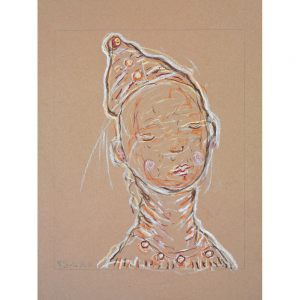Philippe Saxer
1965 to 2013, Switzerland
Philippe Saxer grew up in Bümpliz, a neighbourhood in the western part of Bern, and completed an apprenticeship as an ornamental glazier. From very early on he began drawing and painting of his own accord and selling his works for quite modest prices.
Mental illness necessitated repeated stays in psychiatric clinics. This brought him to the Waldau clinic at the University Hospital of Psychiatry Bern (UPD), where he quickly felt more at home than he had at group residences or when living on his own. From 2006 Philippe Saxer began working at the ‘Kunstwerkstatt’, an artists’ workshop at Waldau that Vorarlberg painter Otto Frick had established in 2003 as an association. Frick was an important promoter of the arts at Waldau, similar to the psychiatrist Walter Morgenthaler, who discovered Adolf Wölfli. Saxer and Frick had actually known each other since 1986. And soon Otto Frick offered him a space at the Waldau painting shop where he could pursue his artistic activities.
Philippe Saxer worked quickly, with incredible regularity and expressiveness. He wanted to be both fast and sweeping in the art he created. Provided with large sheets of paper that Otto Frick had hung on the wall for him, he would – according to Frick – study these blank surfaces as if in a trance or a state of ecstasy before reaching for a brush or paint. It is precisely in this inner space of emergence, when an artist stands before a blank canvas, that – according to Otto Scharmer – artistic creativity arises.
In addition to works of glass, Philippe Saxer’s œuvre includes thousands of works, from oil paintings to watercolours, drawings and figures. His art was exhibited during his lifetime in numerous (group) exhibitions from Europe to Kyoto, Japan. Alfredo Knuchel’s 2004 documentary film Halleluja! The Lord is Mad depicts Philippe Saxer alongside other artists from the Waldau psychiatric clinic. Philippe Saxer died at age 48 on 22 December 2013, just before Christmas. He had taken an overdose of pills at his home in Ostermundigen, in the Canton of Bern.
In 2017 and 2018, the charitable association ‘Friends of Philippe Saxer’, which counts his father amongst its members, documented, catalogued and donated a large number of his works to European museums and private collectors. Their aim is to introduce his work to a wider public. Pieces by him can be found, for example, in the Museum im Lagerhaus, St. Gallen, and in the collections of Korine and Max E. Ammann and of Karin and Gerhard Dammann, both in Switzerland.
Selected works




